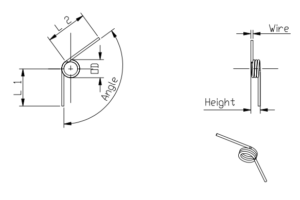Understanding Torsion Spring Load: Principles and Considerations
 Torsion springs play a crucial role in various mechanical applications where rotational force or torque needs to be applied. The load capacity of a spring is a critical factor in ensuring optimal performance and maintaining the integrity of the system. This article aims to provide insights into torsion spring load, including its definition, factors affecting it, and considerations for designing and selecting torsion springs with appropriate load capacities.
Torsion springs play a crucial role in various mechanical applications where rotational force or torque needs to be applied. The load capacity of a spring is a critical factor in ensuring optimal performance and maintaining the integrity of the system. This article aims to provide insights into torsion spring load, including its definition, factors affecting it, and considerations for designing and selecting torsion springs with appropriate load capacities.
1. Definition of Torsion Spring Load:
It refers to the force or torque applied to a torsion spring, which causes it to twist or rotate about its axis. It is typically measured in units of force (Newton or pound-force) or torque (Newton-meters or pound-feet). The load capacity of a torsion spring is determined by its physical properties, including the wire diameter, coil diameter, number of coils, and the material’s mechanical properties.
2. Factors Affecting Torsion Spring Load:
Several factors influence the load capacity. These factors must be carefully considered during the design and selection process:
a. Wire Diameter:
The wire diameter directly affects the stiffness and load-carrying capacity of a spring. As the wire diameter increases, the spring’s strength and load capacity also increase.
b. Coil Diameter:
The coil diameter determines the leverage or moment arm length. Larger coil diameters result in higher rotational forces and increased load capacity.
c. Number of Coils:
The number of coils impacts its loading capacity too. Increasing the number of coils generally increases the stiffness and load-carrying capacity.
d. Material Selection:
The choice of material for a torsion springs is crucial. Different materials possess varying mechanical properties, such as yield strength and modulus of elasticity, which directly affect the spring’s load capacity. Common materials used for torsion springs include stainless steel, carbon steel, and various alloys.
e. Deflection and Stress Analysis:
Accurate analysis of deflection and stress in a torsion spring is essential to ensure it operates within safe load limits. Finite element analysis (FEA) and other analytical methods help determine the optimal load capacity while considering factors such as stress distribution and fatigue life.
3. Design and Selection Considerations:
When designing or selecting a torsion springs with appropriate load capacity, engineers should consider the following:
a. Application Requirements:
Understand the specific requirements of the application, including rotational force/torque, cycle life, environmental conditions, and space limitations.
b. Safety Factors:
Incorporate appropriate safety factors to ensure the torsion spring operates within its elastic limit and does not experience excessive stress or deformation during operation.
c. Material Choice:
Select a material that suits the application’s demands, taking into account factors such as corrosion resistance, temperature range, and required load capacity.
d. Manufacturing Processes:
Consider the feasibility and cost-effectiveness of the chosen manufacturing processes for producing torsion springs with the desired load capacity.
e. Testing and Validation:
Perform rigorous testing and validation to verify the the spring’s load capacity, including endurance tests and simulations to ensure its reliability and performance under real-world conditions.
Conclusion:
It is a fundamental aspect of designing and selecting torsion springs for various mechanical applications. Understanding the factors influencing load capacity and considering appropriate design and selection considerations can help ensure reliable and efficient operation. Engineers should carefully analyze the application requirements, conduct stress analysis, and select optimal materials to achieve the desired load capacity and overall performance of torsion springs.






